All about growing garden blueberries

Knowing everything about growing garden blueberries and the rules of care, farmers can get excellent results. You just need to figure out what to do if it grows poorly on the site, and for what year after planting this culture bears fruit. You should also pay attention to advice on agricultural technology.
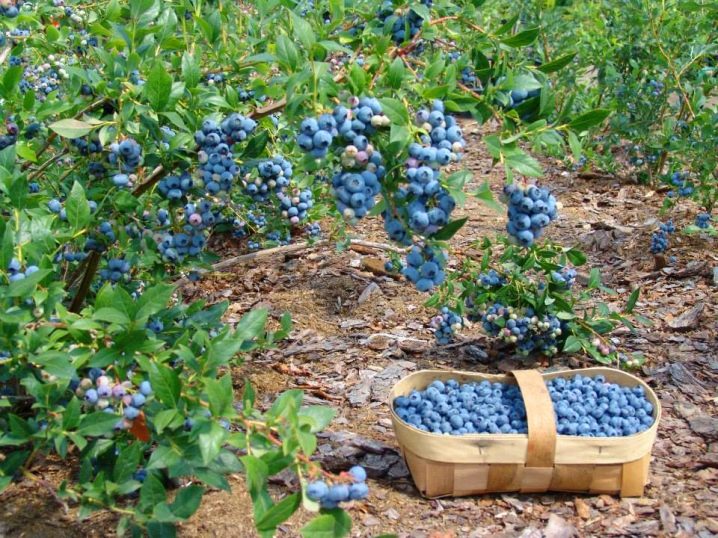
Landing rules
Seat selection
When choosing a place to grow garden blueberries between sun or shade, the preference for sunny areas is quite obvious. This plant should be in open, but at the same time well protected from the wind areas. Fences and screens made of agrofibre turn out to be quite a useful addition. Another way of protection is a green hedge approximately 1 m high; it is enough to provide cover from the wind for 10 m in length.

Optimal landing near the house or fence. The heat-loving culture makes one give preference to the southern sides. Planting blueberries should be far enough away from canopies and tree crowns. Then the shadow they create will not have a bad effect on the plantings. In addition, a tall tree will take up a lot of moisture, which is unlikely to have a positive effect on the development of a shrub.

The soil
Both in a greenhouse and in an open garden, it is easier to care for garden blueberries if they grow on well-drained loose soil. Important: the high standing of soil water for this plant is almost not scary. However, you should still avoid places where moisture stagnates in large quantities. It is unacceptable to use ordinary garden soil. Blueberries react extremely negatively even to long-term applications:
- manure;
- bird droppings;
- wood ash.


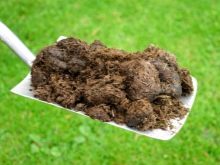
In addition to sand and bark, the substrate for planting includes high-moor red peat. It is worth adding natural sawdust to it. You can also add moss. Experts advise using mineral dressings with a high concentration of sulfur and nitrogen.


It is very important to increase the acidity of the earth.
Garden blueberries need soil with a pH of no more than 4.5. Vinegar, citric and oxalic acid are suitable from the available means to increase acidity. Caution: If the pH is changed too much, the foliage will turn red. This is a sign that a little alkali needs to be added. It is worth considering laying out mulch, which will preserve the sensitive superficial root system.

For mulching it is recommended to use:
- peat;
- hay;
- straw;
- bark;
- leaves;
- washed and calcined river sand.

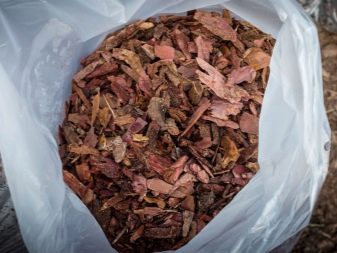


Agricultural techniques
Even with the most competent choice of a site and preparation of the land, the correct landing technology remains relevant. Blueberry bushes need to be arranged in rows. If the plants reach an impressive height, the gap between them should be 150 cm.When growing undersized specimens, this gap can be reduced to 100 cm.

The row spacings must be kept at a level of at least 200 cm, while the specific variety does not matter. With plantation cultivation, the aisles are planned taking into account the passage of equipment.
In order for the plant to please gardeners all year round, you need to pay attention to other nuances. Planting all year round is only possible in a heated greenhouse under controlled conditions. On the street, you will have to focus on the weather and the condition of the seedling. If the plant has free roots, then it is supposed to plant it before the onset of the growing season or after its lasting completion in the fall.With a closed root system, planting is possible in May and August, and in general during the growing season.
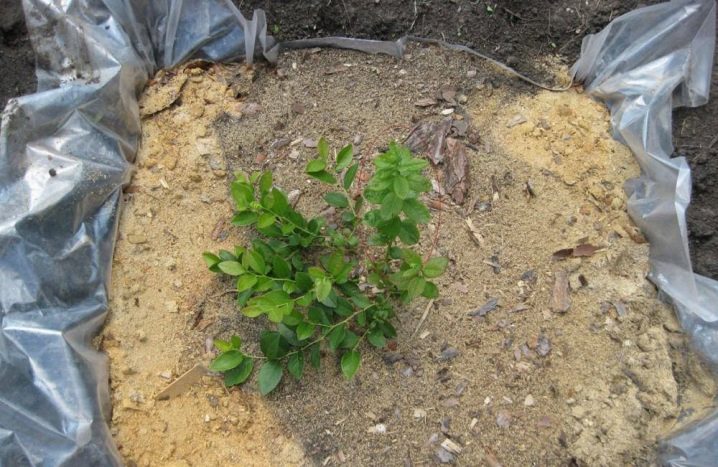
Sowing harvested blueberry seeds is preferable in the last third of summer. The dried seeds will have to be stratified. They are kept for 90 days in a mixture of sand and moistened moss. This stratification is carried out with the expectation of ending before the onset of the horticultural spring.
Suitable containers can be pots, ordinary cups, and even boxes. Moistened peat is placed in them. The seeds are laid out strictly on the surface, without the slightest deepening. To cover the seed, thin glass or transparent polyethylene is used.
The seedlings should be kept warm to speed up germination and to be ready for planting in their final location. Summer transplants should be avoided whenever possible because they are risky - especially without proper all-round care.

How to water?
In the first 60-90 days, watering intervals should be 2 or 3 days. At this moment, the developing plant actively picks up moisture from the external environment and may suffer from its deficiency. In this case, a large amount of water is not required to be used. This mode provides a good survival rate of the root system.
The soil must be kept moist (but not wet!).
Once rooting is complete, less irrigation is required. At this point, 1 time in 2 weeks is already enough. On relatively dry soils at moderately high air temperatures, watering is carried out three times a month. During hot dry periods, garden blueberries should be watered twice a week, in the morning and evening hours, and in the daytime the bushes are sprayed to create coolness. At the stages of flowering and laying of fruits, both waterlogging and desiccation are equally contraindicated.

Pruning
In principle, it is impossible to do without such a procedure. It most often involves thinning out overly dense branches. It is appropriate to combine this approach with the elimination of weakened and diseased shoots. In the spring, they usually resort to formative pruning. This method allows you to initially set the required crown geometry and then maintain it.
The blueberry bush, after proper pruning, is not only decorative in itself, but also well lit by the sun. This means that its vegetation goes on without any problems. A normally trimmed plant is even less sick. In the first few years, it is important to form a strong skeleton that can withstand the stress of the fetus. Only then it makes sense to move on to regulating the size and geometry of the crown.

The first efforts to model the bush should be done as early as possible, while the seedling is in the container. All broken, withered and affected shoots should be destroyed. If they are infected, they will have to be burned. Pruning for rejuvenation is usually done after the bush reaches the age of 10 years. However, you can do this earlier if his condition inspires concern.
If the tool is taken in the spring, then it must be done before the active growing season begins.... In the autumn months, you should wait for leaf fall, but control so that at least 30 more days remain before frost. In the warmest regions of the Russian Federation, pruning of blueberries is also possible in the winter months. The pruning shears cut out overgrowth with a section of no more than 15 mm. For powerful branches, you will have to use a delimber, and for the largest ones, a garden hacksaw.
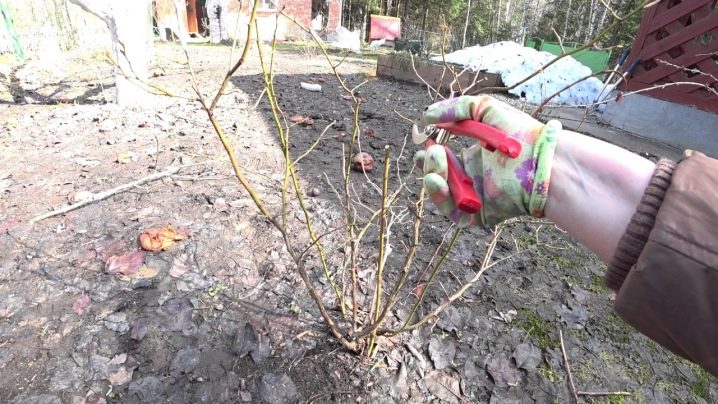
A decent, well-groomed blueberry bush contains 10 to 15 main branches. In a neglected state, there may be noticeably more of them. In this case, you will have to remove the horizontal shoots (up to the point where the first strong vertical branch grows). Additionally, they get rid of second-order processes growing downward or into the inner part of the crown.
You will also have to remove low bushy shoots and those branches of the second order that are below knee level on fruiting trunks.
Sick, mechanically deformed or frost-bruised shoots will have to be removed without waiting for the right season. Together with the problematic part, at least another 2 cm of healthy tissue is removed in order to reduce the spread of fungus or other infection. When the pruning is over, all cuts are carefully treated with a fungicide or insecticidal preparation. Working tools are pre-disinfected, and everything that is cut off must be burned. Disinfection of instruments should be carried out with the transition to each new bush, so that the transfer of infection is excluded.

Top dressing
Feeding garden blueberries is far more important than most common berry bushes. This is due to the special needs of the plant. The usual composition of the soil does not always satisfy them. It should be borne in mind that illiterate feeding threatens with a number of additional problems. The plant may weaken or start to hurt, and a drop in yield cannot be ruled out.
The higher the blueberries, the more of each fertilizer should be used. Any organic matter, as well as compounds containing nitrates or chlorine, is categorically unacceptable. Fertilizers designed for other berry crops should also be avoided (since they will alkalize the soil). We must also give up the intention to feed the blueberries with yeast.

They have a good effect on the condition of other plants, but they are harmful for this species.
If the culture does not grow well, then the acidity of the soil should be checked. Also, the problem may be related to:
- landing in the shade;
- illiterate use of fertilizers;
- bad pollination;
- the absence of mycorrhiza (without it, normal development is completely impossible).
Whatever fertilizer you dare to feed the blueberries, the correct scheme for introducing minerals and complex compositions is very important. The popular Florovit is applied directly to the soil, for the first time in April. The scattered granules of the drug are embedded in the ground and watered. When acidifying the soil with citric acid, the proportions are 30 ml per 10 liters of water. Potassium sulfate is normally applied annually 1 time so that fruiting is more efficient.
In the first feeding of the season, a combination of ammonium sulfate with superphosphate and phosphorus-potassium fertilizer (for example, potassium sulfate) can be used. A ratio of 1 to 2 to 1 should be maintained between them. The use of potassium monophosphate is also allowed. Essential Nutrient Requirements:
- nitrogen - 0.05-0.06 kg;
- phosphorus - 0.03-0.05 kg;
- potassium - 0.03-0.04 kg.


Reproduction
Cuttings can be used to breed garden blueberries. In this case, shoots will develop from existing buds. The age of the shoots used is a very important condition for success. The higher the level of lignification, the lower the intensity of metabolic processes and the lower the water content. Therefore, it is advisable to use young planting material.

Lignified cuttings are used if you need to transport them over a long distance or plant in the next season. Even agronomists cannot offer the best option in this case.
Greenhouse conditions must be created in containers and other containers. The height of the ridges or flower beds is at least 15 or 20 cm. Optimal development of cuttings occurs when using a combination of high-moor peat with washed river sand (in equal volumes).
Lignified cuttings are placed according to the 5x3 system. Green shoots should be planted in a 5x5 system. 1 or 2 buds should remain on the surface of the substrate. Until complete rooting, a temperature of 20 to 25 degrees should be maintained; it is equally important to monitor the constant moisture content of the substrate.

Diseases and pests
When white bloom appears on the leaves, it can be assumed that the cause is powdery mildew. For its treatment, treatment with the drug "Topaz" is carried out. You need to use it strictly according to the instructions.

Stem cancer is recognized by the reddening and subsequent death of the shoots, as well as by spots on the surface of the foliage.To combat the disease, use "Topsin" or Bordeaux liquid.

The already mentioned "Topsin" helps with fomoz. Instead, you can use, however, and "Speed". The appearance of cracks on the wellbore is associated with an incorrect acid-base balance, temperature fluctuations, and mechanical defects. Sometimes the leaves turn yellow and fall off; then there is the previously mentioned phomosis. All diseased parts of the plant with him, alas, will have to be destroyed.

The nuances of care depending on the region
It is hardly possible to grow blueberries in a country house or on a house plot, as well as on an industrial scale without taking into account the peculiarities of the terrain. In the Volga region - namely in Tatarstan, in the Nizhny Novgorod region and other localities in the middle lane - both late spring and early autumn (in September) planting are allowed. Watering is recommended even in moderate rainfall. Loosening is carried out to a depth of a maximum of 10 cm. Before the onset of winter, a shelter is built from spruce branches.
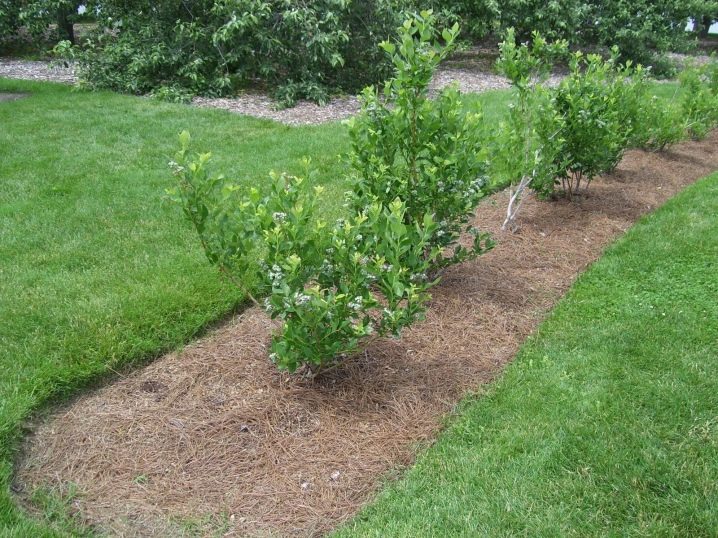
Normally, blueberries begin to produce berries 4 or 5 years after planting. However, the year in which the plant bears fruit after planting, of course, also affects the climatic characteristics of the area.
Although it is a northern berry, it can be cultivated even in Crimea. There you have to use special pots that prevent chaotic growth, and also diligently water the plants. In the south, it is required to use a peat substrate - this point has to be taken into account in the Rostov region.

In the middle lane, including in the Black Earth Region, one must not forget about the danger of frosts in early spring and early autumn. We'll have to abandon the use of late and especially late varieties. But the early and middle varieties perform well. It is very important to take care of protection before the onset of winter. Mulching is strictly necessary, and a layer of mulch thinner than 10 cm cannot be used.

In the Primorsky Territory and other regions of the Far East, it is more correct to grow narrow-leaved blueberries. Tall varieties will have to be planted at your own peril and risk, feeling like a variety tester. The most cold-resistant types of shrubs are suitable for Siberia. They are also recommended for the Urals, for the north of the European part of the Russian Federation. In any case, the winter temperature is critical - 40 degrees; if it goes even lower, the blueberry bushes will not survive.

Preparing for winter
Garden blueberries are very susceptible to harsh conditions and are greatly affected by frost. Therefore, when growing in open ground, it will be necessary to cover the planted culture. Formally, this is a winter-hardy plant originating from North America. The problem is that natural protection only works when a dense snow cover forms.

And in late autumn, when it is windy, damp and cool, shelter is all the more necessary.
It is created immediately after harvest. Preparing for winter also includes:
- wellness pruning;
- the laying of mineral fertilizers;
- breeding blueberries.

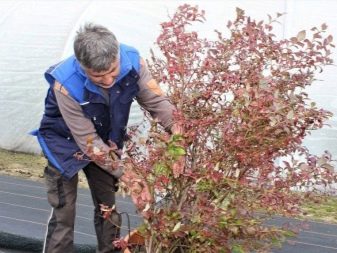













The comment was sent successfully.